As SaaS developers with a wealth of experience in crafting elegant and user-friendly software solutions, we at Era Biz are excited to share our insights into the world of SaaS application development.
As an experienced SaaS development company, we have witnessed firsthand the transformative power of cloud-based applications. They’ve revolutionized the way businesses operate, streamlining workflows, enhancing collaboration, and empowering users to achieve more, and are one of the most popular types of applications that we build currently. But behind the seamless user experience lies a complex world of design, development, and deployment.
Through countless hours of coding, debugging, and refining, we have gained a deep understanding of the key considerations, challenges, and best practices that shape the creation of successful SaaS applications.
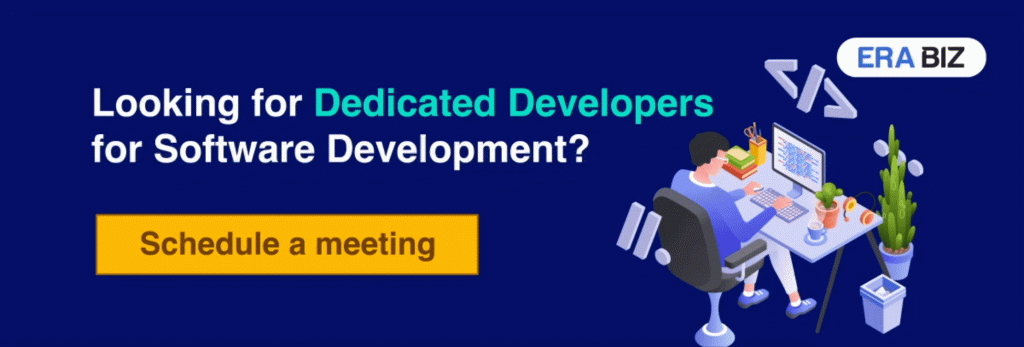
In this guide, we will provide you with answers to questions you may have and a comprehensive overview of the SaaS development process, covering everything from ideation and design to deployment and maintenance.
We will also share our insights from Era Biz Solutions on how to overcome common challenges and achieve success in the ever-evolving SaaS landscape.
Whether you are a seasoned company looking to develop your own branded and complex SaaS Application or an entrepreneur just starting out, we believe that this guide will provide you with valuable information that you can use to create successful SaaS applications.
We invite you to join us on this journey of discovery as we unravel the mysteries of SaaS application development.
Table of Contents
- What are SaaS Applications?
- What are the Key Features and Benefits of a SaaS Application?
- How do SaaS Applications address Specific Business Needs?
- What are the Pricing Models for SaaS Applications?
- What is the Level of Security and Compliance offered by SaaS Applications?
- How do SaaS Applications integrate with Existing Systems?
- What is the Level of Customer Support offered by the SaaS Provider?
- What is the Roadmap for Future Development of SaaS Applications?
- How does the SaaS Application in question compare with Competing Solutions?
- What are the Terms of the SaaS Agreement?
- What is the Development Methodology used for the SaaS Application?
- What is the Technology Stack used to Develop SaaS Applications?
- How SaaS Applications are Designed to be Scalable
- SaaS Applications: How are they Designed to be Secure?
- How Can You Test SaaS Applications?
- How are SaaS Applications Deployed and Maintained?
- What is the Process for Developing Your SaaS Application and How Can You Make Changes?
- How is the SaaS application documented?
- What is the cost of developing a SaaS application?
- Why Select Era Biz for SaaS Application Development?
1. What are SaaS Applications?
Software as a Service (SaaS) applications are cloud-based applications hosted in data centers that are delivered to users over the internet. SaaS applications are typically accessed through a web browser, and they do not require any software installation on the user’s computer.
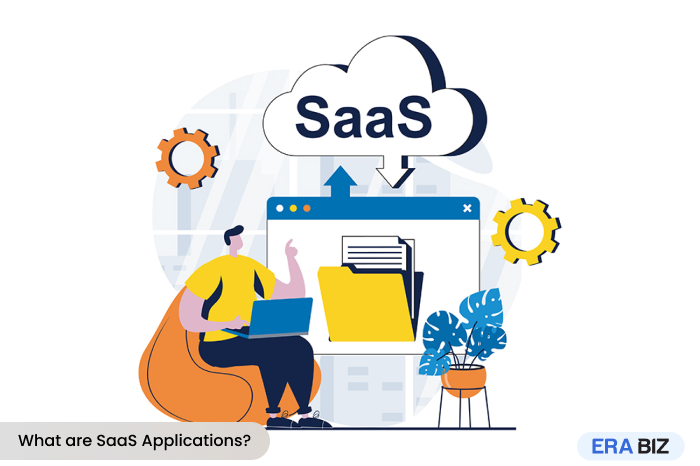
The market for SaaS applications is rising swiftly with Statista forecasting that the global spending on public cloud application SaaS will reach USD 232.3 billion by 2024, which is an increase of nearly 40% from the USD 167.34 billion in 2022. In 2022, it was calculated that there were approximately 17,000 SaaS companies in the USA (including major tech companies such as Apple, Microsoft and Google) with over 59 billion customers. Read our article on Cloud Computing to know more statistics related to cloud based applications.
2. What are the Key Features and Benefits of a SaaS Application?
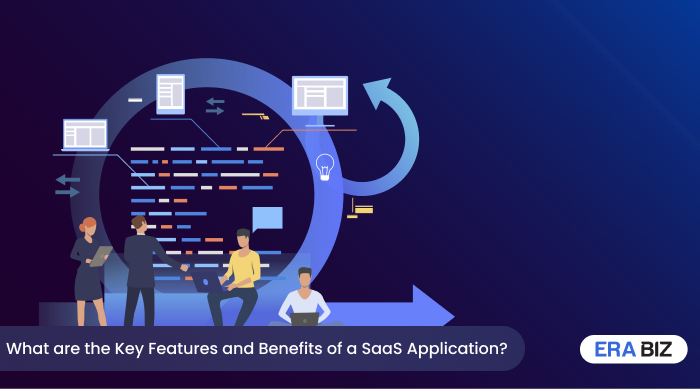
- Accessibility: SaaS applications can be accessed from any device that has an internet connection.
- Scalability: SaaS applications may simply be scaled up or down according to the demands of an expanding or contracting user base.
- Cost-effectiveness: Typically, SaaS solutions are less expensive than traditional software licensing.
- Usability: SaaS applications are often simple to use, especially for individuals with less technical knowledge.
- Regular updates: SaaS applications are updated on a regular basis with new features and security patches.
3. How do SaaS Applications address Specific Business Needs?
SaaS applications can be used to address a wide range of business needs. Here are some of the ways Era Biz clients use SaaS applications:
- Customer relationship management (CRM): Cultivating connections and fostering loyalty throughout the customer lifecycle.
- Enterprise resource planning (ERP): Streamlining core business processes and unifying data across an organization.
- Human capital management (HCM): Optimizing the workforce through talent acquisition, development, and retention.
- Project management: Orchestrating tasks, resources, and timelines to achieve goals on time and within budget.
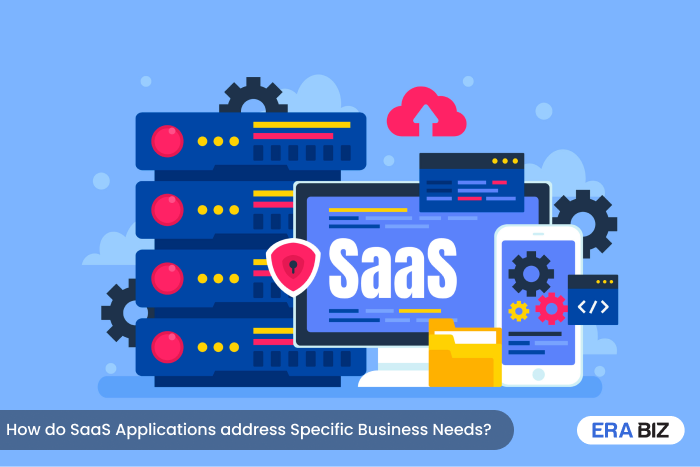
- Marketing automation: Nurturing leads, engaging prospects, and driving conversions through targeted campaigns.
- Sales automation: Streamlining the sales process, boosting productivity, and closing more deals.
- E-commerce: Facilitating online transactions, providing seamless shopping experiences, and expanding market reach.
- Content management: Creating, managing, and delivering engaging content that informs, educates, and inspires.
- Data analytics: Uncovering insights from data, informing decision-making, and driving business growth.
4. What are the Pricing Models for SaaS Applications?
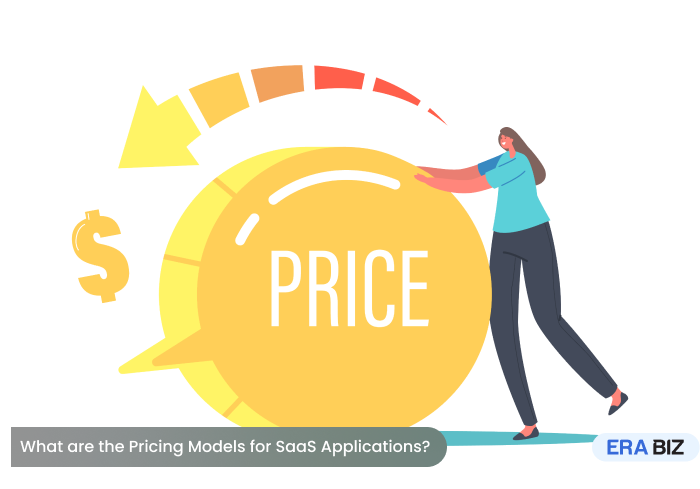
There are a number of different pricing models for SaaS applications. Some common pricing models include:
- Subscription: Users pay a monthly or annual fee to access the SaaS application. The fee will depend on the complexity of the application and the charges of the developers.
- Per-user: Users are charged a fee for each user who accesses the SaaS application. This can be a very expensive method for large organizations.
- Per-usage: Users are charged a fee based on their usage of the SaaS application.
- Tiered: Users are charged a fee based on the level of features and functionality they access. That is, in tiers of functionality.
- Lifetime Deal: A one-time purchase of a SaaS application that is a very cost-effective option for those who don’t want to pay subscriptions.
5. What is the Level of Security and Compliance offered by SaaS Applications?
SaaS Application Developers are generally responsible for the security of the data stored in their applications. They typically offer a high level of security, and they are often compliant with industry-specific regulations.
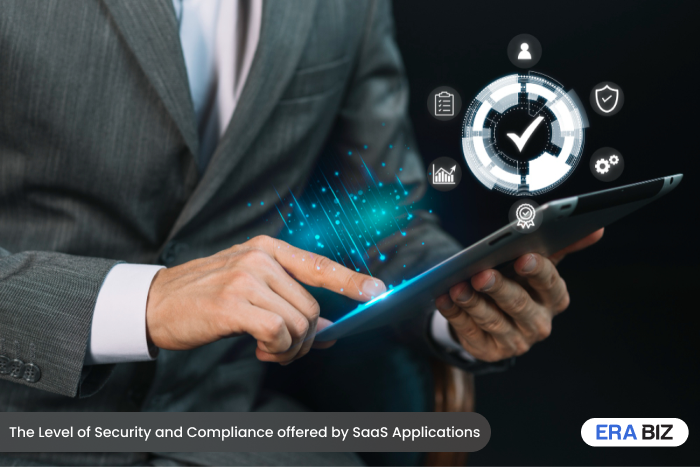
For example, Era Biz protects its clients with ironclad privacy and data protection policies, while also using to secure software development practices. Clients are also able to request additional security and compliance levels such as security background checks on developers involved in projects (especially for fintech).
Want to learn more about our secure software development practices and how we can help you with your SaaS Application? Contact us for a free consultation!
6. How do SaaS Applications integrate with Existing Systems?
SaaS applications can be integrated with existing systems using a variety of methods. Some common integration methods include:
- APIs: APIs (application programming interfaces) allow SaaS applications to exchange data with other applications.
- Webhooks: Webhooks are a type of notification that allows SaaS applications to be notified of events that occur in other applications.
- Data connectors: Data connectors are pre-built integrations that allow SaaS applications to connect to specific data sources.
Notably, Era Biz offers a team to help you integrate your existing system with our SaaS applications.
7. What is the Level of Customer Support offered by the SaaS Provider?
SaaS providers typically offer a high level of customer support. Customer support is provided via email, phone, or chat. In addition, some companies such as Era Biz may provide dedicated project managers and a deployment team to ensure that the setup is perfectly integrated and error-free.
8. What is the Roadmap for Future Development of SaaS Applications?
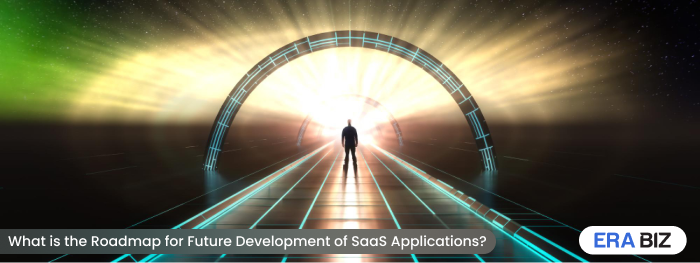
SaaS providers typically have a roadmap for future development of their applications. The roadmap outlines the features and functionality that are planned for future releases of the application. You will need to check with your SaaS application developer for this information as it will vary from application to application. At Era Biz we are always happy to provide our clients with the roadmap that we have planned for their SaaS application when they request it.
9. How does the SaaS Application in question compare with Competing Solutions?
When evaluating SaaS applications, it is important to compare them to competing solutions. Factors to consider when comparing SaaS applications include:
- Features and functionality
- Pricing
- Security
- Compliance
- Customer support
- Roadmap for future development
10. What are the Terms of the SaaS Agreement?
The SaaS agreement is a legal contract between the SaaS provider and the customer. The SaaS agreement outlines the terms of the relationship between the two parties. Here are the important terms we normally include in Era Biz SaaS agreements that should definitely be in any SaaS agreement you sign:
- Pricing
The pricing terms of a SaaS agreement typically specify the amount of money that the customer will pay to the SaaS provider for access to the SaaS application. While the exact amount may change later depending on additional terms requested by the customer, the limits of this change may be mentioned in the agreement as well.
- Service Levels
The service level terms of a SaaS agreement typically specify the level of service that the SaaS provider is obligated to provide to the customer. Common service level terms include:
- Uptime: The percentage of time that the SaaS application is available for use.
- Response time: The amount of time it takes the SaaS provider to respond to customer inquiries.
- Resolution time: The amount of time it takes the SaaS provider to resolve customer issues.
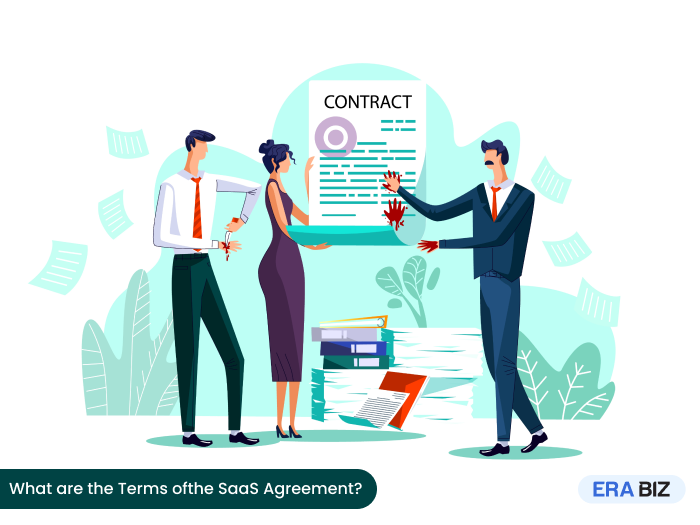
- Data ownership
The data ownership terms of a SaaS agreement typically specify who owns the data that is stored in the SaaS application. In some cases, the SaaS provider owns the data. In other cases, the customer owns the data.
- Intellectual property
The intellectual property terms of a SaaS agreement typically specify who owns the intellectual property rights to the SaaS application. In most cases, the SaaS provider owns the intellectual property rights to the SaaS application. However, the customer may have certain rights to use the SaaS application.
- Termination
The termination terms of a SaaS agreement typically specify the conditions under which either party can terminate the agreement. Common termination terms include:
- For cause: Either party can terminate the agreement if the other party breaches the agreement.
- At will: Either party can terminate the agreement for any reason, upon providing the other party with notice.
Other important terms
In addition to the terms listed above, SaaS agreements may also include other important terms, such as:
- Confidentiality: The terms related to how the SaaS provider will keep any customer data that it receives confidential .
- Indemnification: The SaaS provider’s terms of indemnification to the customer for any damages that arise from the use of the SaaS application.
- Governing law: The law/s that will govern the interpretation of the agreement.
It is important for customers to carefully review the terms of a SaaS agreement before signing it.
11. What are the Development Methodologies used for SaaS Applications?
The development methodology is the overarching approach used to guide the development process of a SaaS application. It defines the phases, roles, and responsibilities involved in bringing a SaaS application from conception to deployment.
A. Common development methodologies include:
Here are the common development methodologies that clients are able to use in Era Biz Solutions. However, we use Agile Development Methodologies with a strong dose of DevOps for the most part.
Waterfall
The Waterfall methodology is a traditional approach to software development that is characterized by its linear and sequential nature. In a Waterfall project, the development process is divided into distinct phases, such as requirements gathering, design, development, testing, and deployment. Each phase must be completed before the next phase can begin.
Pros:
- Provides a clear and structured approach to development
- Helps to ensure that all requirements are gathered and considered before development begins
- Reduces the risk of scope creep
- Facilitates communication and coordination between stakeholders
Cons:
- Can be inflexible and slow to respond to change
- If requirements are not well-defined can lead to problems
- As feedback is only obtained in the end, can result in a product that does not meet the needs of users
Agile
The Agile methodology is an iterative and incremental approach to software development that is characterized by its focus on flexibility and responsiveness to change. In an Agile project, the development process is divided into short cycles, or sprints. Each sprint typically lasts for one to two weeks. At the end of each sprint, a working version of the product is delivered to stakeholders.
Pros:
- Is more flexible and responsive to change than the Waterfall methodology
- Allows for early feedback from stakeholders
- Helps to ensure that the product meets the needs of users
- Can help to reduce the risk of project failure
Cons:
- Can be more chaotic and difficult to manage than the Waterfall methodology
- It can be more difficult to track progress and measure success in Agile without the right tools
- Agile Development requires a high level of communication and collaboration between stakeholders
DevOps
DevOps is a collaborative approach to software development that combines the development, operations, and security teams into a single unit. The goal of DevOps is to shorten the development cycle and provide continuous delivery of software.
Pros:
- DevOps is an excellent way to shorten the development cycle
- Can help to improve the quality of software
- It helps to reduce the risk of deployment failures
- DevOps can improve communication and collaboration between teams
Cons:
- As an entirely new approach DevOps requires a change in culture and mindset
- Due to multitude of factors DevOps can be difficult to implement in large organizations and development teams
- Can require a high level of technical expertise
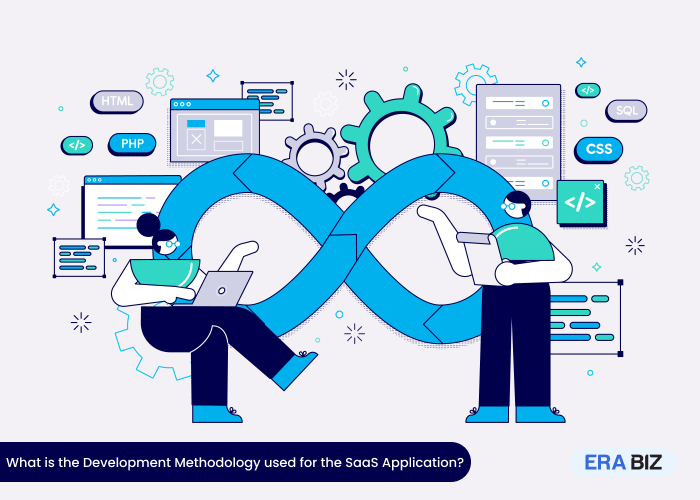
B. The Choice of Development Methodology
The choice of development methodology depends on a number of factors, such as the size and complexity of the SaaS application, the level of certainty in the requirements, the desired speed of delivery, and the culture and risk tolerance of the organization.
In general, the Waterfall methodology is a good choice for projects with clearly defined requirements and a low risk of change.
The Agile methodology is best for projects with changing requirements or a high degree of uncertainty.
And the DevOps methodology is most appropriate when you require rapid delivery and continuous improvement.
Era Biz usually uses a combination of Agile Development Methodologies with DevOps to provide the highest efficiency and effectiveness.
12. What is the Technology Stack used to Develop SaaS Applications?
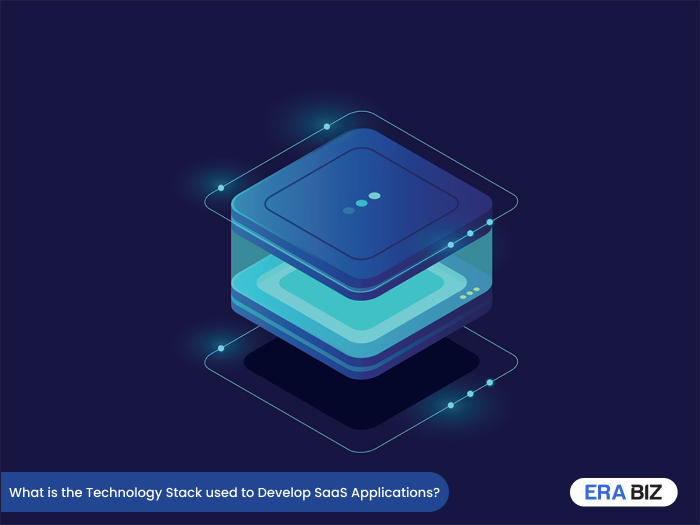
The technology stack is the set of technologies used to develop the SaaS application. Common technologies used to develop SaaS applications include:
- Programming languages (e.g., Java, Python, Laravel)
- Frameworks (e.g., React, Next, Django, Rails)
- Databases (e.g., MySQL, PostgreSQL, MongoDB)
- Cloud platforms (e.g., AWS, Azure, GCP)
13. How SaaS Applications are Designed to be Scalable?
Scalability is the ability of a system to handle increasing amounts of load. SaaS applications are typically designed to be scalable by using a distributed architecture. A distributed architecture is a type of architecture in which the application is divided into multiple components that are spread across multiple servers.
According to tests run by Era Biz, our SaaS applications are able to withstand well over a thousand users at any given time. (Verified with our clients)
14. SaaS Applications: How are they Designed to be Secure?
Security is a critical consideration for any SaaS application. SaaS providers typically implement a number of security measures to protect customer data. Some common security measures include:
- Encryption: Data is encrypted at rest and in transit.
- Authentication: Users are required to authenticate themselves before they can access the application.
- Authorization: Users are only granted access to the data and functionality that they are authorized to access.
- Auditing: All user activity is logged and audited.
- Penetration testing: The application is regularly subjected to penetration testing to identify and remediate security vulnerabilities.
15. How do you Test SaaS Applications?
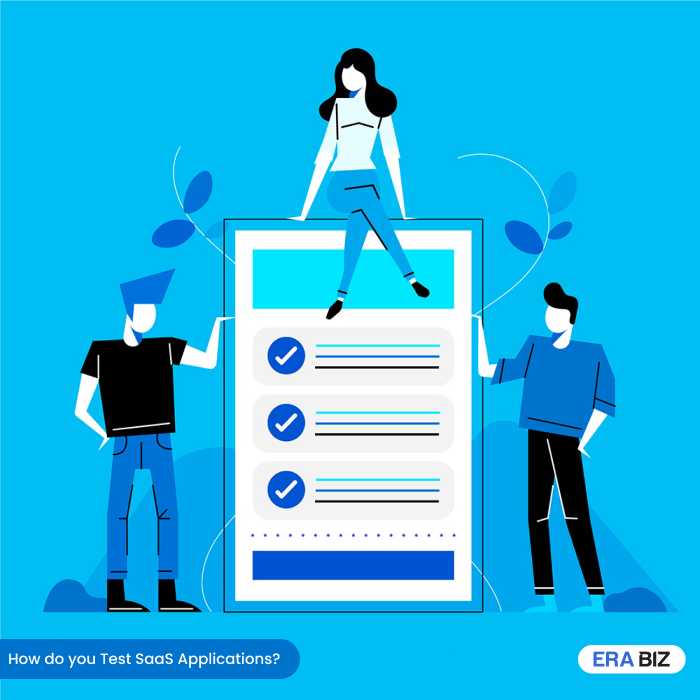
SaaS applications are typically subjected to a rigorous testing process. The testing process typically includes:
- Unit testing: Individual units of code are tested to ensure that they are working correctly.
- Integration testing: Different components of the application are tested to ensure that they are working correctly together.
- System testing: The entire application is tested to ensure that it is working correctly.
- User acceptance testing: Users test the application to ensure that it meets their needs.
16. How are SaaS Applications Deployed and Maintained?
SaaS applications are typically deployed on a cloud platform. The SaaS provider is responsible for releasing and maintaining the application. They typically take care of all of the underlying infrastructure, such as servers, storage, and networking.
17. What is the Process for Developing Your SaaS Application and How Can You Make Changes?
The development process for a SaaS application typically involves the following steps:
- Requirements gathering: Once you decide to obtain a SaaS application for a certain purpose you will first need to find your specific needs / requirements. This will help you to understand what features and functionality they need in your application.
- Choosing a SaaS Provider: Compare the offerings of different SaaS providers and select the most appropriate one. See the answers above to find what you need to look at while making your choice.
- Hire Team and Start Development: In most cases the SaaS provider will already have some similar applications or customizable applications that they develop further according to your needs. Such customization can allow very fast results. If developing from scratch, you may have to hire a team to design and develop your SaaS application.
- Testing and Deployment: Once your application is developed, you need to test it thoroughly to ensure that it is working properly. This will involve conducting many types of tests, such as unit testing, integration testing, user testing and system testing. Once your application is tested, you can deploy it to a production environment making it available to users.
- Maintenance and Support: Later your SaaS provider may give you a fixed time for any maintenance, updates, or changes needed. After this additional support can be obtained by paying a maintenance fee. However, if you use the subscription option, this maintenance fee is included in your package.
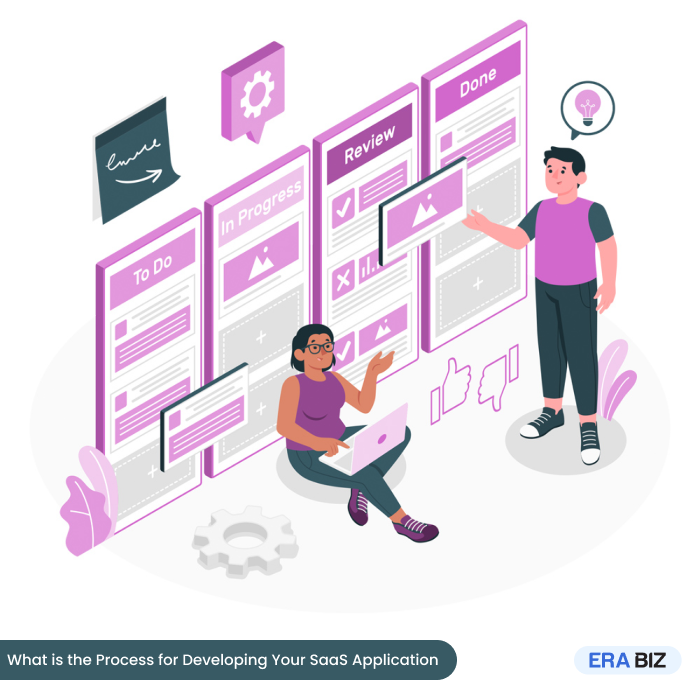
SaaS providers, such as Era Biz Solutions, typically have a process for making changes to their applications after deployment. The process typically includes:
- Gathering user feedback
- Prioritizing changes
- Developing and testing changes
- Deploying changes
18. How is the SaaS application documented?
SaaS applications are typically well-documented. The documentation typically includes:
- User guides: Easy-to-understand guides for your end-users on how to use the SaaS application
- Technical manuals: Can be used by developers and/or users to gain an in-depth understanding of the technical workings of your SaaS application.
- API documentation (These are references and tutorials for developers who use the APIs of the SaaS application)
19. What is the cost of developing a SaaS application?
The cost of developing a SaaS application can vary depending on a number of factors, such as the size and complexity of the application, and the place of development. According to general calculations, the cost of developing a SaaS application is typically in the range of $100,000 to $1,000,000 when developed in countries such as the USA.
20. Why Select Era Biz for SaaS Application Development?
Era Biz Solutions is a leading SaaS application development company in the UK and Sri Lanka that was formed in 2011. With a proven track record of success, the organization provides custom software development, web development, and mobile app development services to clients in a transparent and reliable manner.
The organization is known for the innovation and creativity of its talented dedicated developers and dedicated teams, specialized in remote work, sourced at its tech hub in Sri Lanka. In addition, Era Biz also has a number of flagship SaaS applications for CRM, ERP, LMS and Logistics that have many loyal users over the years. It is committed to delivering high-quality, scalable, and secure SaaS applications that can create digital transformation for businesses of all sizes and categories.
Here’s why Era Biz should be your top choice:
- Deep SaaS Expertise: Our team isn’t just skilled in coding; we understand the unique challenges and opportunities of SaaS development. We’ve helped numerous businesses craft successful SaaS solutions, from ideation and architecture to deployment and ongoing maintenance.
- Focus on User Experience: We believe a stellar user experience is the cornerstone of any successful SaaS application. Era Biz Solutions employs user-centric design methodologies to ensure your application is intuitive, engaging, and delivers exceptional value to your users.
- Agility and Scalability: We understand the need for your SaaS application to adapt and grow with your business. We leverage Agile development methodologies and cloud-based technologies to ensure your application can scale seamlessly and effortlessly.
- Security and Reliability: In today’s digital world, security is paramount. Our team adheres to the highest security standards and practices to ensure your data and user information are always protected. We build reliable and robust applications that can withstand even the most demanding workloads.
- Cost-Effectiveness: We believe in delivering maximum value for your investment. We offer transparent pricing models and avoid vendor lock-in, ensuring you get the most out of your budget. We help you optimize your development process and choose the right technologies to keep costs under control.
- Dedicated Partnership: We don’t just build your application; we become your trusted partner throughout your SaaS journey. We provide ongoing support, maintenance, and strategic guidance to help you achieve your business goals.
- Proven Track Record: We have a rich portfolio of successful SaaS applications across diverse industries. From CRM and marketing automation to collaboration tools and data analytics, we have the experience and expertise to bring your SaaS vision to life.
- Ready to propel your SaaS application to success? Choose Era Biz as your development partner and experience the difference. We’ll bring together our expertise, dedication, and passion to help you build a secure, scalable, and user-centric SaaS application that drives real business value.
Conclusion:
At Era Biz Solutions, we believe the future of software is bright, powered by the agility and scalability of SaaS solutions. As your trusted partner in the digital landscape, we’re equipped to guide you through every step of the SaaS development journey, from conceptualization to deployment and beyond.
Whether you’re a budding entrepreneur with a groundbreaking idea or an established enterprise seeking to modernize your operations, our skilled team is here to unlock the potential of SaaS for your unique needs. With our comprehensive development expertise, unwavering commitment to excellence, and dedication to building long-term partnerships, we’re confident in empowering you to achieve remarkable results.
So, are you ready to revolutionize your software landscape and embrace the future of SaaS? Contact Era Biz Solutions today, and let’s embark on this exciting journey together!


Can you be more specific about the content of your article? After reading it, I still have some doubts. Hope you can help me.
I don’t think the title of your article matches the content lol. Just kidding, mainly because I had some doubts after reading the article.
Your article helped me a lot, is there any more related content? Thanks!
I don’t think the title of your article matches the content lol. Just kidding, mainly because I had some doubts after reading the article.
Thanks for sharing. I read many of your blog posts, cool, your blog is very good.
Thanks for sharing. I read many of your blog posts, cool, your blog is very good.
Your point of view caught my eye and was very interesting. Thanks. I have a question for you.
Can you be more specific about the content of your article? After reading it, I still have some doubts. Hope you can help me.
Hey there! Do you know if they make any plugins to assist
with SEO? I’m trying to get my site to rank for some targeted keywords but I’m not seeing very good
gains. If you know of any please share. Appreciate it! I saw similar
text here: Eco bij
Thank you for your sharing. I am worried that I lack creative ideas. It is your article that makes me full of hope. Thank you. But, I have a question, can you help me?
I don’t think the title of your article matches the content lol. Just kidding, mainly because I had some doubts after reading the article.
Your point of view caught my eye and was very interesting. Thanks. I have a question for you.
Can you be more specific about the content of your article? After reading it, I still have some doubts. Hope you can help me. https://www.binance.com/register?ref=P9L9FQKY
I don’t think the title of your article matches the content lol. Just kidding, mainly because I had some doubts after reading the article.
Your point of view caught my eye and was very interesting. Thanks. I have a question for you.
Can you be more specific about the content of your article? After reading it, I still have some doubts. Hope you can help me.
Thanks for sharing. I read many of your blog posts, cool, your blog is very good.
I don’t think the title of your article matches the content lol. Just kidding, mainly because I had some doubts after reading the article.
Can you be more specific about the content of your article? After reading it, I still have some doubts. Hope you can help me.
Can you be more specific about the content of your article? After reading it, I still have some doubts. Hope you can help me.
Your point of view caught my eye and was very interesting. Thanks. I have a question for you.
Can you be more specific about the content of your article? After reading it, I still have some doubts. Hope you can help me.
Thanks for sharing. I read many of your blog posts, cool, your blog is very good. https://www.binance.com/pt-BR/join?ref=YY80CKRN
Thank you for your sharing. I am worried that I lack creative ideas. It is your article that makes me full of hope. Thank you. But, I have a question, can you help me? https://accounts.binance.com/es-MX/register-person?ref=JHQQKNKN
I don’t think the title of your article matches the content lol. Just kidding, mainly because I had some doubts after reading the article.
Hello! Do you know if they make any plugins to assist with Search Engine
Optimization? I’m trying to get my blog to rank for some targeted keywords but
I’m not seeing very good gains. If you know of any please share.
Many thanks! I saw similar art here: Code of destiny
Can you be more specific about the content of your article? After reading it, I still have some doubts. Hope you can help me.
Can you be more specific about the content of your article? After reading it, I still have some doubts. Hope you can help me.
I am extremely impressed along with your writing skills and also with the layout in your weblog. Is this a paid theme or did you modify it your self? Either way keep up the nice quality writing, it’s rare to see a nice weblog like this one nowadays. I like erabizsolutions.io ! My is: TikTok Algorithm
I am extremely impressed together with your writing skills and also with the layout to your weblog. Is this a paid topic or did you modify it yourself? Either way stay up the nice high quality writing, it is rare to see a great blog like this one these days. I like erabizsolutions.io ! It’s my: Stan Store
Your point of view caught my eye and was very interesting. Thanks. I have a question for you.
I don’t think the title of your article matches the content lol. Just kidding, mainly because I had some doubts after reading the article.
Your point of view caught my eye and was very interesting. Thanks. I have a question for you.
Can you be more specific about the content of your article? After reading it, I still have some doubts. Hope you can help me.
Thanks for sharing. I read many of your blog posts, cool, your blog is very good.
I don’t think the title of your article matches the content lol. Just kidding, mainly because I had some doubts after reading the article.
Thank you for your sharing. I am worried that I lack creative ideas. It is your article that makes me full of hope. Thank you. But, I have a question, can you help me? https://accounts.binance.com/es/register?ref=T7KCZASX
Your article helped me a lot, is there any more related content? Thanks!
Can you be more specific about the content of your article? After reading it, I still have some doubts. Hope you can help me.
Your point of view caught my eye and was very interesting. Thanks. I have a question for you.
Thanks for sharing. I read many of your blog posts, cool, your blog is very good.
Thank you for your sharing. I am worried that I lack creative ideas. It is your article that makes me full of hope. Thank you. But, I have a question, can you help me?